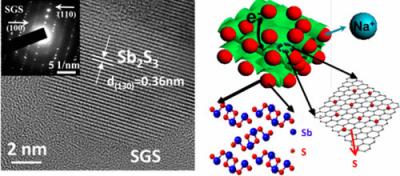Researchers from the South China University of Technology, National Taiwan Normal University and the U.S-based Georgia Institute of Technology have developed a graphene-based anode material that enables sodium-ion batteries to perform at high capacity over hundreds of cycles.

The high-performance anode material was created by binding an antimony-based mineral onto sulfur-doped graphene sheets. Incorporating the anode into a sodium-ion battery allowed it to perform at 83% capacity over 900 cycles. The researchers say this is the best reported performance for a sodium-ion battery with an antimony-based anode material.
To ultimately commercialize their technology, they would need to scale up battery fabrication while maintaining its high performance. Sodium-ion batteries are considered to be a safer and lower-cost candidate for large-scale energy storage than lithium-ion. But so far, they have not operated at high capacity for long-term use. Lithium and sodium have similar properties in many ways, but sodium ions are much larger than lithium ions. This size difference leads to the rapid deterioration of a key battery component. The anode material created in this study could have potential to give sodium-ion batteries a longer life and make them more commercialy viable.